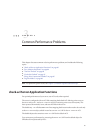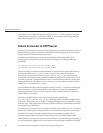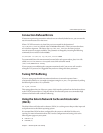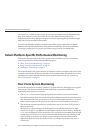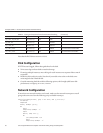
Connection Refused Errors
If users are experiencing connection refused errors on a heavily loaded server, you can tune the
use of network resources on the server.
When a TCP/IP connection is closed, the port is not reused for the duration of
tcp_time_wait_interval (default value of 240000 milliseconds). This is to ensure that there
are no leftover segments. The shorter the tcp_time_wait_interval, the faster precious
network resources are again available. This parameter is changed by executing the following
command (do not reduce it below 60000):
usr/sbin/ndd -set /dev/tcp tcp_time_wait_interval 60000
To automatically have this ndd command executed after each system reboot, place it in a le
called /etc/init.d/network-tuning and create a link to that le named
/etc/rc2.d/S99network-tuning.
If your system is not exhibiting the symptoms mentioned, and if you are not well-versed in
tuning the TCP protocol, it is suggested that you do not change the above parameter.
Tuning TCP Buering
If you are seeing unpredictable intermittent slowdowns in network response from a
consistently loaded server, you might investigate setting the sq_max_size parameter by adding
the following line to the /etc/system le:
set sq_max_size=512
This setting adjusts the size of the sync queue, which transfers packets from the hardware driver
to the TCP/IP protocol driver. Using the value of 512 allows the queue to accommodate high
volumes of network trac without overowing.
Using the Solaris Network Cache and Accelerator
(SNCA)
The Solaris Network Cache and Accelerator (SNCA) is a caching server that provides improved
web performance to the Solaris operating system.
It is assumed that SNCA has been congured for the system on which the Web Server is
running. For more information about SNCA and its conguration and tuning, refer to the
following man pages on your system:
■
ncab2clf(1)
■
ncakmod(1)
SolarisPlatform-SpecicIssues
Chapter4 • Platform-SpecicIssuesandTips 91





